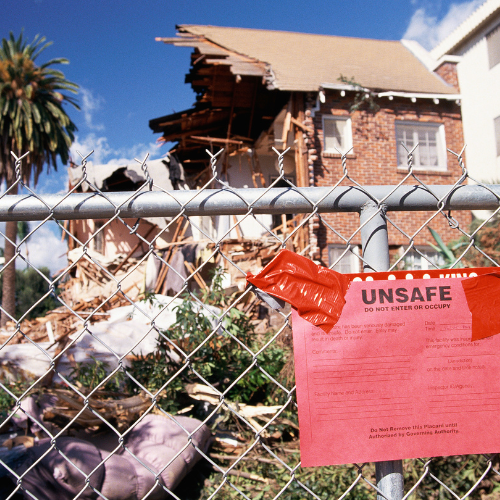
Although the property damage, injuries, and business interruptions directly caused by natural disasters often receive significant attention, businesses face risks even after such weather events have passed. These include health and safety hazards, financial losses, and reputational damage. Yet employers should also consider the environmental effects of these events, especially since traditional insurance policies may limit or exclude related coverage.
Examples of Environmental Risks After Natural Disasters
Natural disasters can create conditions that lead to severe environmental hazards, such as:
- Mold—Water intrusions from severe weather events like floods and hurricanes can lead to mold growth throughout a company’s building, and wet building materials, such as drywall and wood, can create environments conducive to mold growth. According to the Centers for Disease Control and Prevention, mold can cause many adverse health effects, including respiratory problems, burning eyes or rashes. Individuals with asthma or mold allergies may also have severe reactions, and people who are immunocompromised and those with chronic lung disease may develop infections after mold exposure.
- Spills, leaks, and other toxic releases—Natural disasters can damage infrastructure made from hazardous materials, producing toxic building debris. Storage containers holding harmful chemicals can also be damaged, creating leaks, and contaminated waste products on company property can be dispersed into the environment. Such events can pollute the surrounding water, air, and soil. Businesses constructed on historically contaminated grounds (e.g., Superfund sites) are at an elevated risk of toxic releases due to the nature of those areas, even if their operations typically do not generate hazardous materials.
- Fire byproducts—The fires associated with natural disasters can create poor air quality. Whether a severe storm ignites an electrical fire or a wildfire spreads to a building, the materials that burn may create toxic fumes. Additionally, if fires arise, firefighting chemicals containing per- and polyfluoroalkyl substances (PFAS) or other harmful substances may be used to stop them. PFAS are known as forever chemicals because they do not break down, creating further health and environmental risks.
- Disruption of waste management systems—Due to the damage and amount of debris produced by a natural disaster, waste management systems may become disrupted or overwhelmed. For example, sewer systems may not operate properly, causing health risks, or waste removal services may not function, resulting in the buildup of hazardous material.
Actions to Reduce Environmental Liability After Natural Disasters
Employers can implement the following measures to mitigate post-natural disaster risks:
- Conduct thorough environmental risk assessments to identify potential threats and vulnerabilities, including those created by operations, building materials, chemical storage, and waste.
- Establish and regularly update risk management plans that address both immediate and long-term environmental hazards.
- Build and maintain infrastructure with a focus on resilience and sustainability to withstand the impact of natural disasters and lessen potential environmental impacts.
- Prevent pollution by eliminating or reducing the use of hazardous materials, modifying pollution-creating processes, investing in sustainable technologies, and improving waste management systems.
- Provide training and education to employees on proper handling, use, and storage of hazardous materials.
- Stay abreast of relevant environmental regulations and laws applicable to the business and ensure compliance with them.
- Secure insurance that specifically covers exposures and potential liabilities arising from environment-harming incidents, including coverage for property damage, third-party injuries, and costs to clean the area impacted by the event.
- Regularly review and update insurance policies to align with business changes and the evolving risk landscape.
Contact us to see how you could minimize risk:
Recent News
Employee Spotlight: Eric Haberle
Please join us in welcoming Eric Haberle to Seubert’s Employee Benefits Department as a Sr. Benefits Account Manager!
Protecting Against Electrical Room Fires
Electrical rooms can pose significant fire risks if not properly designed, built and maintained. To protect people and property, it is essential for facilities to take targeted steps to mitigate these risks before they escalate.
Employee Spotlight: Natalie Meyer
Seubert welcomes Natalie Meyer to the agency’s Surety Department.
Cyber Hygiene Best Practices
As cyberattacks become more frequent and severe it is increasingly important for organizations to practice good cyber hygiene to minimize their exposure to risk.
The Impact of the Growing Gig Economy
The gig economy is a system in which organizations engage individuals, often through digital platforms or intermediaries, for temporary or task-based work, rather than relying solely on full- and part-time employees.
Employee Spotlight: Clark Rowley
Please help us welcome Clark Rowley to the Seubert Team as a Surety Support Specialist in our Surety Bond Division!

